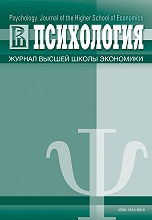Враждебные и доброжелательные аттитюды к мужчинам: Адаптация шкалы амбивалентности к мужчинам на русский язык
Аннотация
В статье описана адаптация шкалы амбивалентных аттитюдов к мужчинам П. Глика и С. Фиск. Процесс адаптации состоял из трех этапов. На первом этапе принимали участие 302 человека с гетеросексуальной ориентацией, которые заполняли оригинальный вариант методики, переведенный на русский язык. Во втором этапе участвовали 157 человек с гетеросексуальной ориентацией, которые заполняли модифицированный вариант методики для измерения амбивалентных аттитюдов к мужчинам и методику для измерения амбивалентных аттитюдов к женщинам. На третьем этапе приняли участие 344 человека с гетеросексуальной и 107 человек с бисексуальной ориентацией, которые заполняли модифицированный вариант методики для измерения амбивалентных аттитюдов к мужчинам, а также опросники для измерения правого авторитаризма и ориентации на социальное доминирование. Результаты продемонстрировали, что русскоязычная версия опросника имеет двухфакторную структуру, обладает надежностью и валидностью. Однако короткая версия методики из 12 утверждений, лучше соответствует эмпирическим данным, чем длинная версия опросника из 20 утверждений.
Скачивания
Литература
2. Altemeyer, B. (1998). The other "authoritarian personality". In M. P. Zanna (Ed.), Advances in experimental social psychology (Vol. 30, pp. 47-92). San Diego, CA: Academic Press. https://doi.org/10.1177/0146167205275614
3. Altemeyer, B. (2006). The authoritarians. Winnipeg, MB: Author. Retrieved from http://theauthoritarians.org/Downloads/TheAuthoritarians.pdf
4. Bendixen, M., & Kennair, L. E. O. (2017). When less is more: Psychometric properties of Norwegian short-forms of the Ambivalent Sexism Scales (ASI and AMI) and the Illinois Rape Myth Acceptance (IRMA) Scale. Scandinavian Journal of Psychology, 58, 541-550. https://doi.org/10.1111/sjop.12392
5. Glick, P., & Fiske, S. T. (1996). The ambivalent sexism inventory: differentiating hostile and benevolent sexism. Journal of Personality and Social Psychology, 70, 491-512. https://doi.org/10.1037/0022-3514.70.3.491
6. Glick, P., & Fiske, S. T. (1999). The ambivalence toward men inventory: Differentiating hostile and benevolent beliefs about men. Psychology of Women Quarterly, 23(3), 519-536. https://doi.org/10.1111/ j.1471-6402.1999.tb00379.x
7. Glick, P., & Fiske, S. T. (2001). Ambivalent sexism. Advances in Experimental Social Psychology, 33, 115-188. https://doi.org/10.1016/S0065-2601(01)80005-8
8. Glick, P., Fiske, S. T., Masser, B., Manganelli, A. M., Huang, L., Castro, Y. R Wells, R. (2004). Bad but bold: Ambivalent attitudes toward men predict gender inequality in 16 nations. Journal of Personality and Social Psychology, 86, 713-728. https://doi.org/10.1037/0022-3514.86.5.713
9. Gulevich, O. A., Agadullina, E. R., & Khukhlaev, O. E. (2018). Approval of Group Hierarchy: Russian Version of Social Dominance Orientation Scale. Psychology. Journal of the Higher School of Economics, 15(3), 407-428.
10. Lee, T. L., Fiske, S. T., Glick, P., & Chen, Z. (2010). Ambivalent sexism in close relationships: (Hostile) power and (benevolent) romance shape relationship ideals. Sex Roles, 62, 583-601. https://doi.org/10.1007/s11199-010-9770-x
11. Pratto, F., Sidanius, J., & Levin, S. (2006). Social dominance theory and the dynamics of intergroup relations: Taking stock and looking forward. European Review of Social Psychology, 17, 271-320. https://doi.org/10.1080/10463280601055772
12. Pratto, F., Sidanius, J., Stallworth, L. M., & Malle, B. F. (1994). Social dominance orientation: A personality variable predicting social and political attitudes. Journal of Personality and Social Psychology, 67, 741-763. https://doi.org/10.1037/0022-3514.67.4.741
13. Rollero, C., Glick, P., & Tartaglia, S. (2014). Psychometric properties of short versions of the Ambivalent Sexism Inventory and Ambivalence Toward Men Inventory. TPM, 21, 1-11. https://doi.org/10.4473/TPM21.2.3
14. Sibley, C. G., Robertson, A., & Wilson, M. S. (2006). Social dominance orientation and right-wing authoritarianism: Additive and interactive effects. Political Psychology, 27, 755-768. https://doi.org/10.1111/j.1467-9221.2006.00531.x
15. Sibley, C. G., Wilson, M. S., & Duckitt, J. (2007). Antecedents of men's hostile and benevolent sexism: The dual roles of social dominance orientation and right-wing authoritarianism. Personality and Social Psychology Bulletin, 33, 160-172. https://doi.org/10.1177/0146167206294745
16. Sidanius, J., Pratto, F., van Laar, C., & Levin, S. (2004). Social dominance theory: Its agenda and method. Political Psychology, 25, 845-880. https://doi.org/10.1111/j.1467-9221.2004.00401.x
17. Zawisza, M., Luyt, R., & Zawadzka, A. M. (2012). Ambivalence toward men: Comparing sexism among Polish, South African and British university students. Sex Roles, 66, 453-467. https://doi.org/10.1007/s11199-011-0112-4





